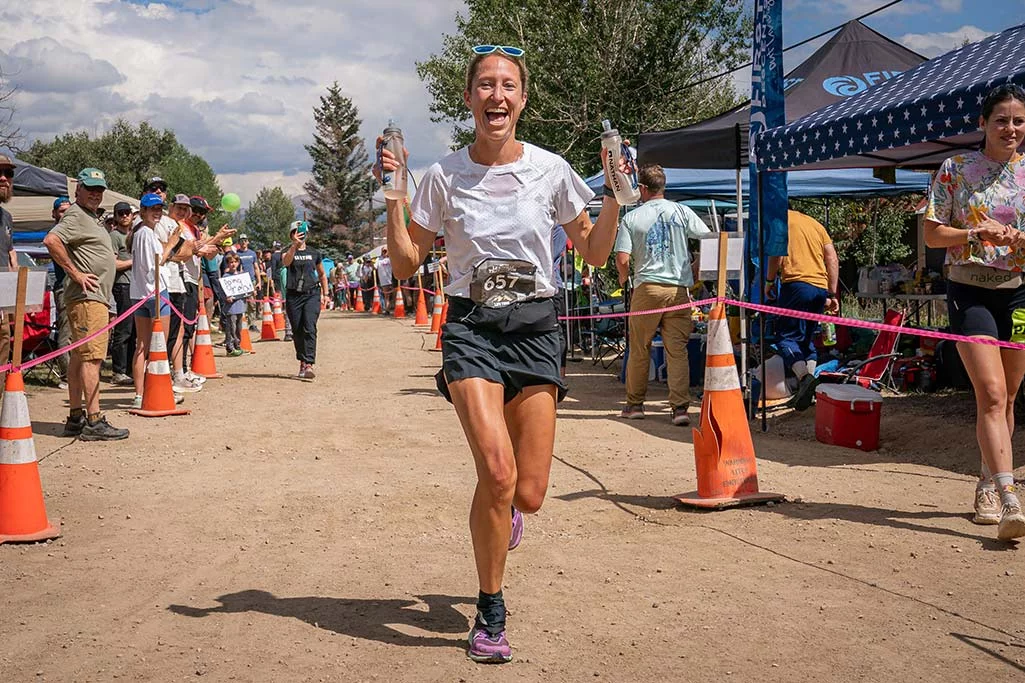
Update: Colorado Springs ER doctor sets a new world record at Tunnel Hill trail races
Dr. Anne Flower has done it again! Since we chronicled Flower’s remarkable August victory at the Leadville Trail 100, she has continued to dazzle the running world.
Flower recently set a new world record in a 50-mile race in Illinois in November. Continue reading to learn about her inspiring performance in Leadville, or read more about Flowers’ new world record at the Tunnel Hill trail races.
At mile 98 of the Leadville Trail 100 Run, Dr. Anne Flower sprinted in the dark toward the finish line in downtown Leadville.
Just two miles to go, and Flower would finish the longest run of her life.
The race had gone well. Over the grueling, high-altitude course, Flower, 35, had been running for more than 17 hours and encountered few problems and suffered no injuries. She saw beautiful vistas, meandered through sun-dappled aspen groves and paused at the top of a 12,500-foot pass for a moment of solitude. Her crew, including her husband, provided all of the snacks, gear and support she needed at each aid station to keep her in fine form.
Now, she was about to meet the seemingly simple goal she set for herself: to finish the race.
And yet, somehow, here at mile 98, something quite improbable was unfolding.
It was 10 p.m. on Aug. 16. Flower was running on a road on the outskirts of Leadville, a historic mining town in central Colorado that is ringed by high peaks, where reminders of its mining past are everywhere. The numbers tell the story here: population 2,600, elevation 10,152, and one million acres of nearby public lands. Running alongside Flower was a friend, serving as her pacer, or running partner.As Flower closed in on mile 99, she approached another racer and his pacer. That pacer had been keeping a close eye on the race stats throughout the grueling day – who was in first, who had what time, how much of the race remained. He called out to Flower and told her that if she picked up her pace, she might win the women’s race or even set a course record.
“Go!” he shouted to her.
Flower knew that her race time so far was good. But she had no idea that she was on the cusp of shattering one of the most enduring and legendary records in ultra running.
Now the finish line was within her grasp. A jolt of adrenaline rushed through her body, and she knew, instinctively, what to do. But would it be enough to power her to a new women’s record?

ER doctor enters debut 100-miler with one goal: Finish
By profession, Flower is an emergency medicine doctor at UCHealth Memorial Hospital Central and other UCHealth free-standing ER locations in Colorado Springs. Long before she joined the ranks of emergency medicine doctors, Flower was an active kid who grew up in Cincinnati, and who fell in love with mountains during trips to the western U.S. She also fell into running as a way to keep in shape and burn off stress.
Flower decided to run in the Leadville 100 just two weeks before the race. She had never competed in a 100-mile ultramarathon, but a good summer of running made Flower curious about whether she could do it. And she was in top running form.
On June 28, Flower ran the Leadville Trail Marathon – and won the women’s race.
She then ran the July 12 Silver Rush 50 Run in Leadville – and won again.
Each of those races was a qualifier for the final event of the series: the 100-mile race. She won commemorative coins that she could trade for entry to the August ultramarathon. It would be a shame to let the opportunity pass, she thought. Race organizers encouraged her to enter. And why not? Her husband was game to run her support crew. If she finished in less than 30 hours — the cutoff time — she would even earn one of the race’s coveted finisher belt buckles.

Travel cultivates a lifelong love for the West
Flower grew up loving soccer and lacrosse and joined the middle school cross-country team. Her mother worked as a school psychologist, and her father was a high school science teacher. Thanks to those jobs, Flower’s parents spent summers on the road with Flower and her two sisters, roaming the West and its iconic spots. By the time she graduated from high school, Flower had spent time in Telluride, Silverton and Ouray, Colorado; Jackson, Wyoming; and Seattle. On winter trips to the west, she and her family skied.
“I didn’t recognize how amazing it was at the time,” she said.
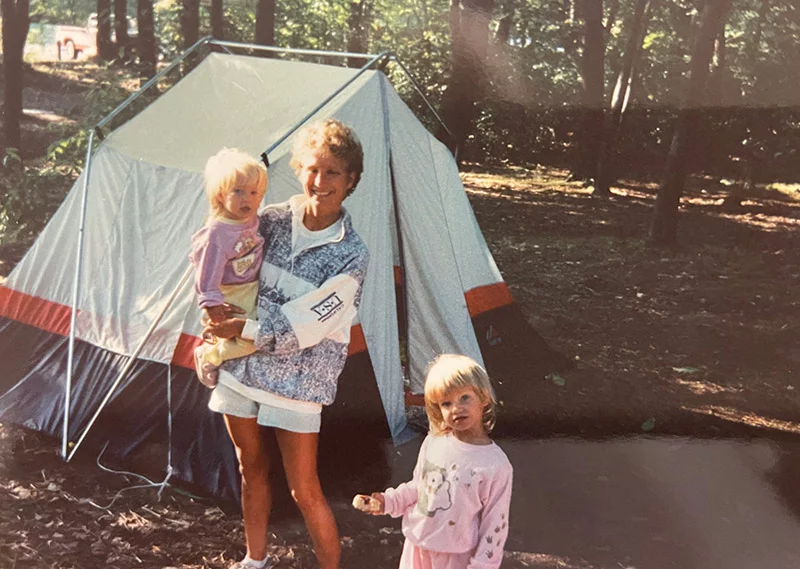
Flower set a goal to attend college in Colorado and, thanks to scholarships, enrolled at Regis University in Denver. She took every opportunity to be in the mountains. Little did she know that she would one day make her home in Colorado, within view of Pikes Peak.
Flower had her eye on medical school, earning undergraduate degrees in biology and Spanish in 2012. But before enrolling, she took a year off, working at a sushi restaurant in Aspen and living near the gondola at Aspen Mountain so she could be on the slopes as much as possible. She logged more than 100 ski days that year, a record envied by avid skiers. Flower started medical school at the Heritage College of Osteopathic Medicine at Ohio University in 2013.
Her third year of medical school was a particularly challenging time, Flower said. She had little control over her schedule and endured what she called lots of “delayed gratification.” More than $200,000 in student debt weighed on her. So, she took up running. She didn’t need much – shoes, shorts and a top. She could fit in a run around her medical school schedule.
Running remained a perfect stress reliever for Flower as she continued her education.
She completed her residency in emergency medicine at the University of Kentucky. And she kept running. She found early successes, figuring out what gear she liked and fine-tuning her approaches to running long distances. She ran her first marathon in 2016 and her first 50-mile trail race in Moab, Utah, in 2019 to celebrate her 30th birthday. In early 2020, she qualified for the Olympic marathon trials just before the COVID-19 pandemic really ramped up. She went to the qualifier event in Atlanta in March, just as everything was shutting down due to the virus. It was a large field of runners, so she knew she was there more for the experience than a shot at the games, which were later postponed.
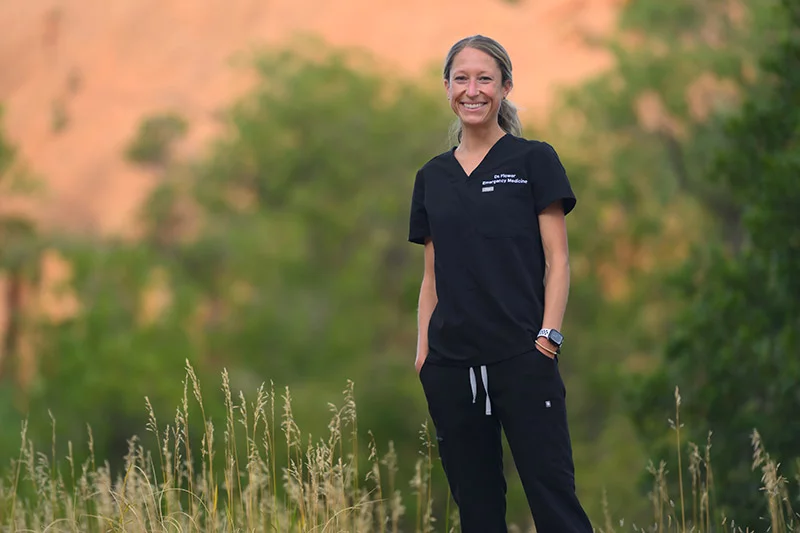
Three years ago, Flower joined UCHealth as an ER doctor.
“I love everything about emergency medicine. I love that we take care of anyone at any time, regardless of who they are,” she said. “We take care of everyone who walks through the door, and I really find that to be something that I take pride in.”
Leadville Trail 100 run: The race to remake a mining town
Trail runners view the 100-mile Leadville race as one of the most iconic, difficult ultramarathons in the world. Runners face challenges on all fronts. Nicknamed “The Race Across the Sky,” the race starts in Leadville, eventually ascending to 12,500 feet. Runners gain more than 15,000 feet in elevation over 100 miles. And the cutoff times are tight. Competitors must finish within 30 hours; those who finish in under 25 hours earn the “Big Buckle.”
Race organizers describe it as “a brutal out-and-back ultramarathon that will push even the toughest runners to their limits.”
The course sends runners out of Leadville, around Turquoise Lake, past the small community of Twin Lakes and then up Hope Pass. Runners descend Hope Pass to arrive at Winfield, the halfway point, then turn around and ascend Hope Pass again from the other side before retracing their steps back to Leadville.
Ken Chlouber, a Leadville miner, businessman and former state legislator, started the race in 1983 with Merilee Maupin, a Leadville businesswoman. Chlouber worried about fallout from the recent closure of the nearby Climax molybdenum mine. He wanted to find a way to bring visitors – and their dollars – to Leadville and to give the historic mining community a new identity.
Forty-five racers signed up for the first race. Today, the Leadville race series draws thousands of runners from around the world.
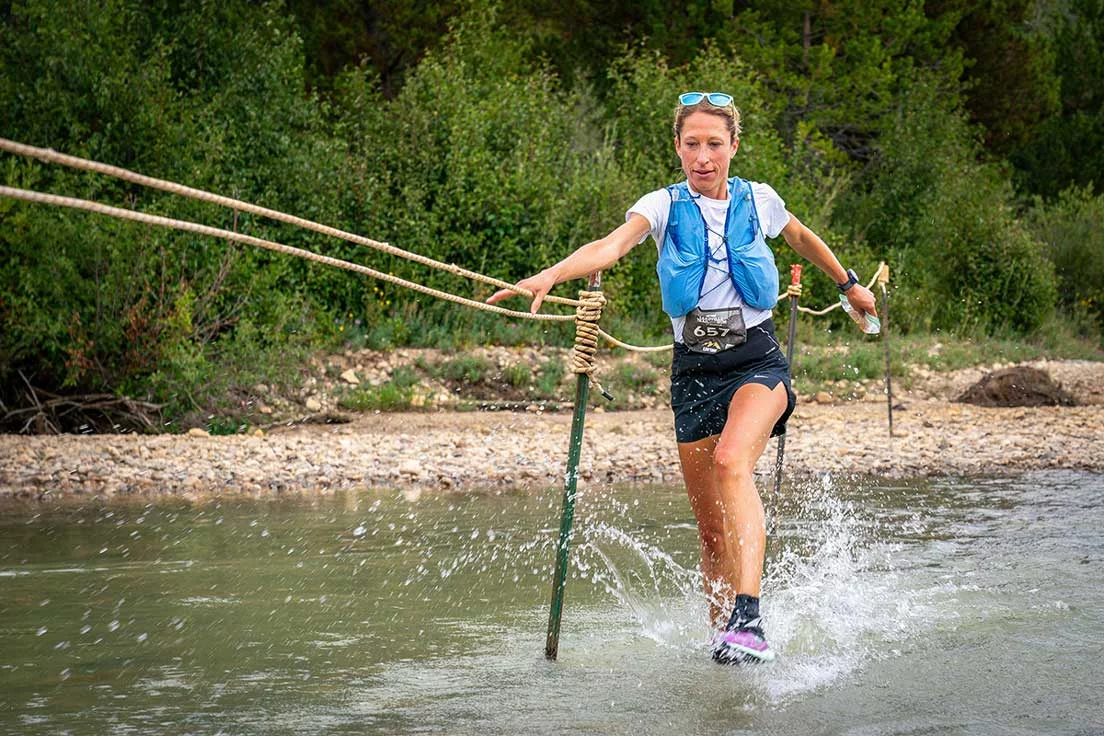
Fun fans and stunning vistas shape early race miles of Leadville Trail 100
Flower described her decision to run the race as a “perfect storm.”
She said she “felt awesome” after the Silver Rush 50 Run in July. Then, in early August, she and her husband, James Patton, camped in the area. She decided to run up Hope Pass and felt good there, too.
But she hadn’t run a 100-mile race before, and she wasn’t sure how her body would hold up.
“My main hesitation was I didn’t want to be broken for weeks afterward,” she said.
The allure of the distance won her over. Flower decided to trade in a chip she had won earlier in the summer for an entry for the 100-mile race.
From prior ultras, she knew what to expect at mile 50. And mile 60.
Miles 65 to 100 were a mystery.
“It was a challenge not having a mental model of a 100,” she said.
Soon, it was race day, with a pre-dawn start in downtown Leadville. Flower was nonchalant, leaving the house she and her crew rented downtown to walk to the starting line about 10 minutes before the start. After the starting gun, Flower focused on keeping her own pace and resisting the urge to go out too fast. A gorgeous sunrise revealed the landscape around her as she logged one mile after another.
Flower saw her crew for the first time at the mile 23 aid station. Besides her husband, the crew included Hannah Allgood, a friend and competitive runner, and her husband, Gil, as well as two childhood friends. Patton had never been a race crew chief before.

“My wife is a badass, and I respect her immensely, and if she needs anything from me, I’m in,” Patton said.
Before the race, Flower created a spreadsheet to guide the crew, listing where each of the five aid stations would be and what she hoped to have at each stop (clean and dry socks and underwear, hydration and snacks, for example). She left blanks where her crew members could record her time at each station, along with times of some of the other racers. Flower arrived at the first aid station about 15 minutes ahead of the time she had estimated.
“She was cruising, having a great time,” Patton said.
Flower dropped her headlamp and running vest in favor of her running belt and, after three minutes, headed out.
“It was like a Formula 1 pit crew,” Patton said. “We knew exactly what she needed and had all the options available to her. It was very efficient. Just in and out. No wasted time.”
Flower knew she would see her crew again at mile 38, then 62. The last stops would be at miles 76 and 87.
Fans at the aid stations buoyed Flower. At the Twin Lakes aid station at mile 38, crowds lined the racecourse, ringing cowbells, yelling for runners and carrying signs with encouraging messages. Patton could see Flower as she approached the aid station – again, about 10 minutes ahead of her plan.
“She was high-fiving people, big smile on her face, just truly having a great time,” he said.
Flower was among the top 10 runners at that point.
On the trail, Flower took in the beauty as the course meandered across streams and into lush pine forests, with views of mountain ranges all around her.
It helped that the race was going well. The first 40 miles were, as Flower said, “very runnable.”
“I was just enjoying every part,” she said.
And there were the mystical things that can happen on a long run.
“That day was impactful for so many reasons,” Flower said.
At the top of Hope Pass, she thought about her friend Stacey, her middle school cross-country teammate. Stacey had become a nurse and had struggled in recent years. She died from a drug overdose on Aug. 8, and her memorial service in Ohio was the same day as the Leadville run. Flower knew their friends would be there.
She stopped where some prayer flags were flapping in the breeze at the top of Hope Pass.
“Stacey, I’m so sorry this happened,” Flower said quietly. “This run is for you.”
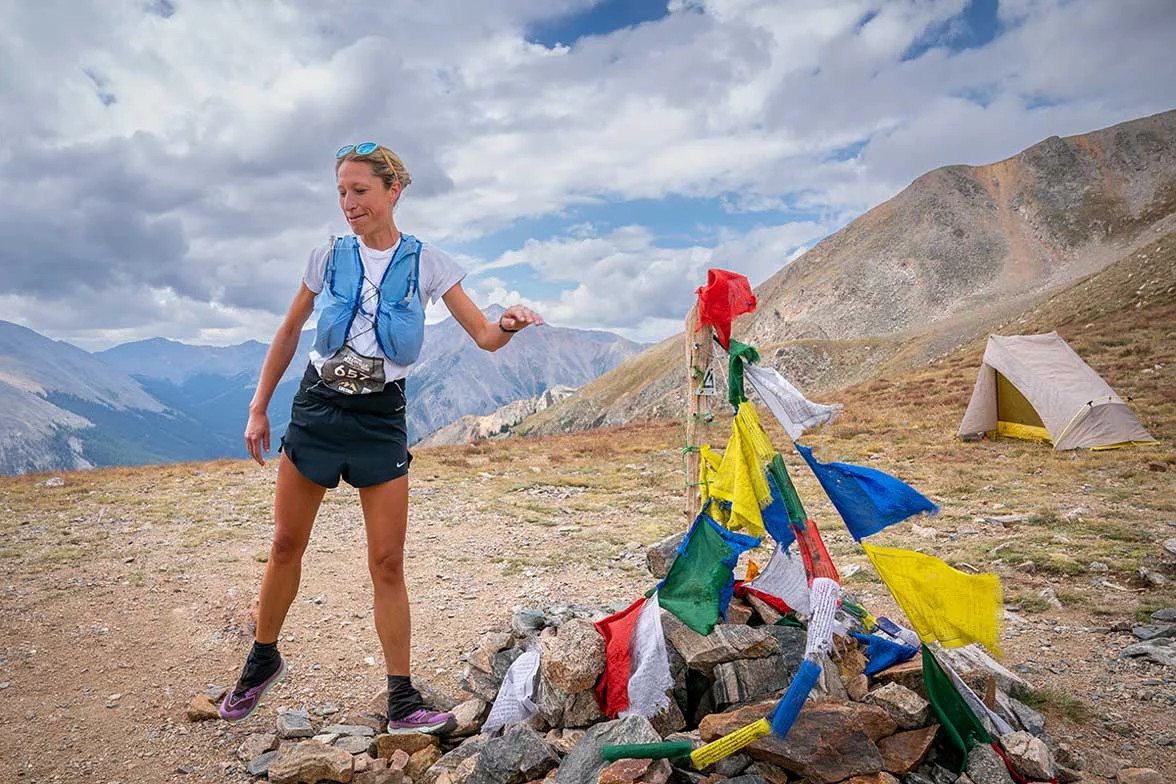
Flower sobbed the entire way back down the pass.
Fatigue and darkness hit at mile 76 for this ultrarunner
At the mile 76 aid station, Patton watched as his wife ran toward her crew. It was 5:40 p.m., and Flower was still running ahead of her plan. Patton noticed, for the first time, a slight change in her running cadence. She was favoring her right side.
The runner in second place was in much worse shape, he noticed, vomiting as he met his crew. Patton turned to Hannah Allgood.
“This looks like an Anne second-place finish to me,’” he said to Allgood.
Leaving the aid station, Flower put on earphones for the first time, and cued up a 90s punk rock mix with some Chappell Roan thrown in. While Patton offered his wife encouragement, Allgood gave her advice.
“You’ve got this,” Allgood told Flower. “Go get it. You need to push it.”
Flower knew she would not see her crew again until mile 87.
Then, she hit the low point of her race. In an event known for superlatives, it is perhaps easy to gloss over what Flower faced at that point. Going up and over Hope Pass – twice – is brutal, and she had done it. She was in first place among the women runners, third overall. But she had 24 miles to go. Sunset was coming, with more darkness ahead.
The entire race was becoming “kind of a drag,” she said.
Exhaustion crept in.
She was alone.
She had slowed to a hiking pace.

The occasional aches and pains from the day were becoming more noticeable. Particularly bothersome, she said, was that the tongue of her shoe was rubbing her foot.
She focused on getting to the mile 87 aid station, where she was looking forward to seeing her husband and crew again. She had written “hugs” on the spreadsheet outlining her requests for each aid station. Gil Allgood, Hannah’s husband, and a long-distance runner himself, would be there. He had offered to join her at mile 87 as a pacer. She looked forward to having a friend run alongside her. Despite her weariness, Flower was confident that she would at least finish the race by the cutoff time, even if she had to walk the last 24 miles.
From her experience in the ER, Flower knew that being in the right headspace can make all the difference when facing a challenging situation. What she lacked in a mental model for a 100-mile race, Flower made up for with the mental model she uses in the ER: “Slow and steady.”
The slow and steady mantra helps Flower keep her head clear, her breathing measured, and her focus sharp at work. When any complex patient can walk through the trauma bay doors, you simply focus on the patient in front of you.
She applied some of the strategies she uses in the ER to this last tough stretch of the run. She took in the information as it came to her: how her stomach, legs and feet felt, what the weather was doing, how far she had to go to the next aid station.
Then, she determined each action she needed to take. Did she need a fresh pair of shoes? Something to eat at the next aid station? More water?
As darkness descended again, Flower kept telling herself, “slow and steady.”
A turnaround at the mile 87 aid station in iconic race
At the mile 87 aid station, around 8 p.m., Patton was getting fidgety, waiting for Flower. He walked 100 yards up the course toward where she would be coming. As she approached, he began to run with her.
“I was talking to her, ‘Hey, what do you need? How do you want to do the aid station? Do you still want Gil to pace? What do you want his pace to be?’”
Flower told him what she needed, then fueled up and got a fresh round of hugs.
“She made very sure to give me a kiss at every aid station — until the last two,” Patton said, with a laugh. “Then, she was more like, ‘I think we’ve just got to finish this thing.’”
Hannah Allgood told Flower that she had a big lead on the second-place woman racer and to “keep moving well.” Flower knew what that meant: Keep your feet going. Don’t walk. Move forward.
Flower left the aid station. Gil Allgood hit the trail alongside her.
“When he became my pacer, he was ready to run, so he was a huge burst of energy, which then got me wanting to run faster,” she said. “He was very encouraging. We chatted for a while, and it was a good distraction, but also helped keep me focused on the task at hand.”
The duo maintained an easy pace, and Flower envisioned herself finishing.
Coming around Turquoise Lake outside of Leadville, she could see campers with headlamps on, creating a long necklace of light along the shore. She told herself to dig deep.
“You’re stronger than you think,” she said to herself.
Crew witnesses epic finish to ER doc’s 100-mile debut
After Flower left the last aid station, Patton and the rest of the crew headed into Leadville for a bite to eat. Patton bought a bouquet of flowers at Safeway and headed to the finish line area. He anxiously paced the area, hoping to hear some news about Flower from the announcer or anyone else keeping track of the runners. The rest of the crew milled around with other fans waiting for the first finishers. They were still about 20 minutes out.
Soon, the announcer came over the loudspeaker. The second-place runner, a man, was still on pace to beat Flower, he said to the crowd.
“It looks like Anne Flower is not going to get the record,” the announcer said.
Patton said he and the crew were disappointed but still excited that Flower would finish in third place overall, first among the women runners.
Meanwhile, out on the trail, Flower and Allgood were closing in on downtown Leadville. She was feeling strong, and Allgood was helping her stay focused.
At mile 98, they came up on the male runner who was in second place and his pacer.
The pacer shouted to Flower that a second-place finish was within reach.
She heard him shout “Go!”
Flower exploded, running faster than she had for miles: a seven-minute pace, perhaps faster. Nearly at the finish line, she was running one of the fastest miles of the entire race.
“The last thing I expected was to have to kick it at mile 99,” Flower said.
Gil Allgood later told Patton that he had to sprint to keep up with Flower – on an uphill grade, no less.
Back at the finish line, the announcer came on the sound system again.
Flower had just passed the second-place runner, he told the crowd. She was now on track to set a new women’s course record.
“You could feel the swell of energy and emotion,” Patton said. “It was an atmosphere that doesn’t happen very often because everyone was rooting for the exact same thing to happen.”
The first-place winner, David Roche of Boulder, had crossed the finish line with a time of 15:12:30.
Patton peered into the darkness. He saw a headlamp turn the corner and head toward the finish line. He knew it was his wife. She was now in second place.
Patton was glued to the race clock.
“It’s 17 hours at that point, and it’s starting to tick up, and tick up, and you can see her light just getting ever closer,” he said.
“This guy comes on the mic, he’s got this great bass voice, and he said, ‘Anne Flower is going to break the record! Come on in, Anne!”
The crowd of 300 people or so at the finish line began screaming. Flower could hear them. She could see the clock at the finish line. She felt light on her feet, kept running hard and crossed the line with a finish time of 17:58:19.
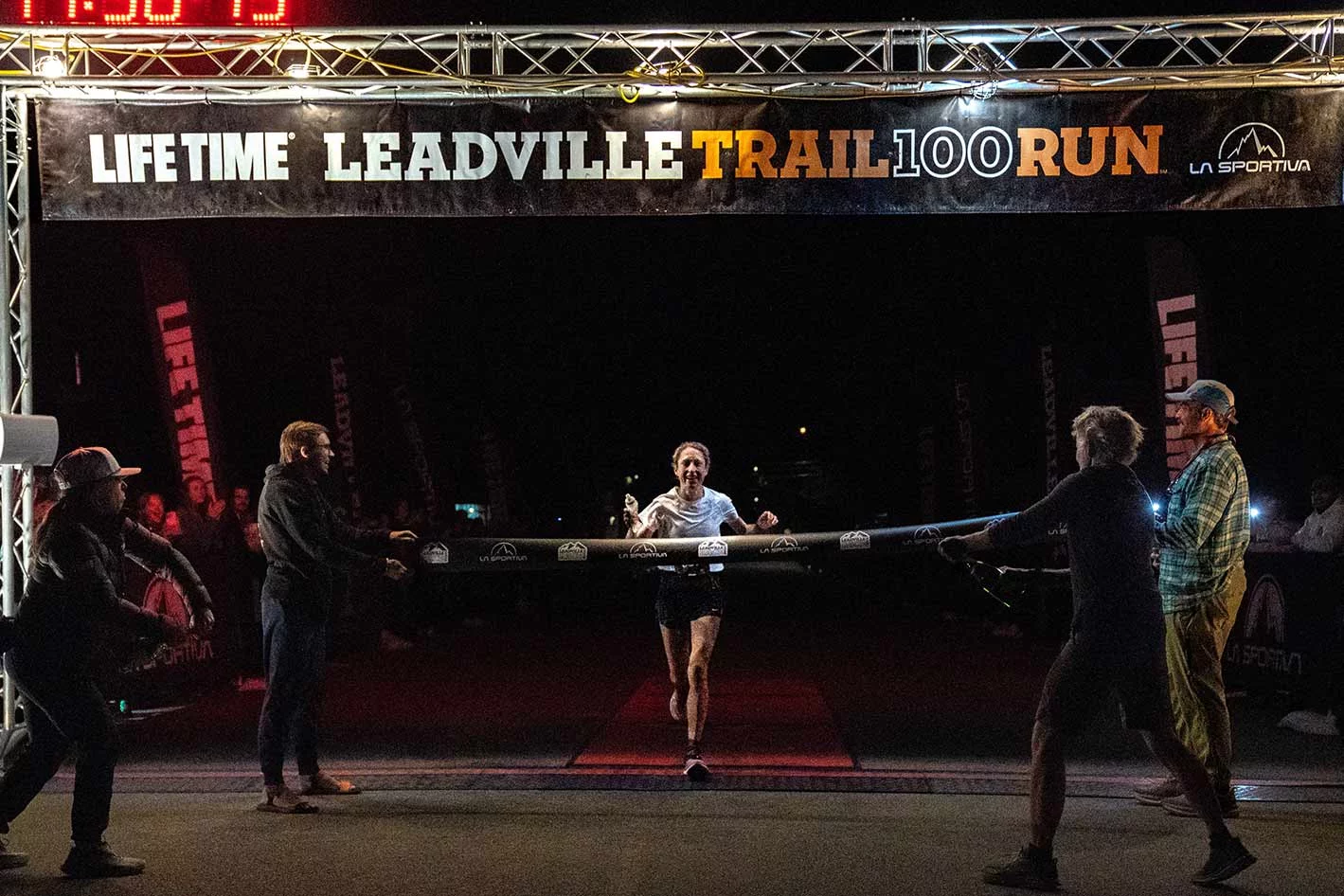
“People were spraying champagne and screaming,” Patton said. “It was truly like a Miracle on Ice finish, when the United States beat the Soviet Union in the Olympics (in hockey). It was truly one of the best sporting event finishes ever. It was unbelievable.”
Flower smashed the 31-year-old Leadville 100 women’s record by eight minutes, in her debut ultramarathon, no less. And in winning the Leadville 100, she swept the Leadville summer race series.
“It was one of the coolest things ever,” she said.
Running and the ER: Parallel paths of focus and endurance
Just a week after the race, Flower declared herself 90% healed and was back to running.
Two hours before her workday at the hospital starts, Flower typically heads outside for a run.
“Running is such an integral part (of my day) because it really helps reset my mind,” she said. “I stop being busy, I take time, I go for a run, I clear my head, and then I get ready to start.”
She then showers and arrives at the hospital about 30 minutes before her shift.
“That’s the last time I have control of my day,” she said.

Flower typically works five morning shifts, five evening shifts and five overnights each month, giving her plenty of time for training runs.
Dr. Michael Mitchell, medical director of the UCHealth Denver metro emergency departments, got to know Flower in 2024 when she offered to help the team there by working an occasional 24-hour ER shift in the south Denver area, in addition to her shifts in Colorado Springs.
Flower is intelligent and humble, a critical combination that makes for a great ER doctor, Mitchell said.
“She has a tremendous work ethic – and that was my initial impression, before I found out that she runs ridiculously long races.”
On a recent episode of the Trail Society podcast, which featured Flower, she described the parallels of running with emergency medicine.
In the ER, she has to control the stimuli she takes in, breathe deeply to slow her heart rate and focus on her skills. Same with running a 100-mile race.
“I recognize it, address it and move on,” she said.
Looking ahead: Medicine, mountains and running, of course
As for what’s next, “that’s a really good question,” Flower said. She and her husband hope to grow their family.
Patton said he jokes with her all the time that “I want to be more like you when I grow up.”
“The humility with which she moves through not just running, but life in general, is one of the most impressive aspects of her personality,” Patton said.
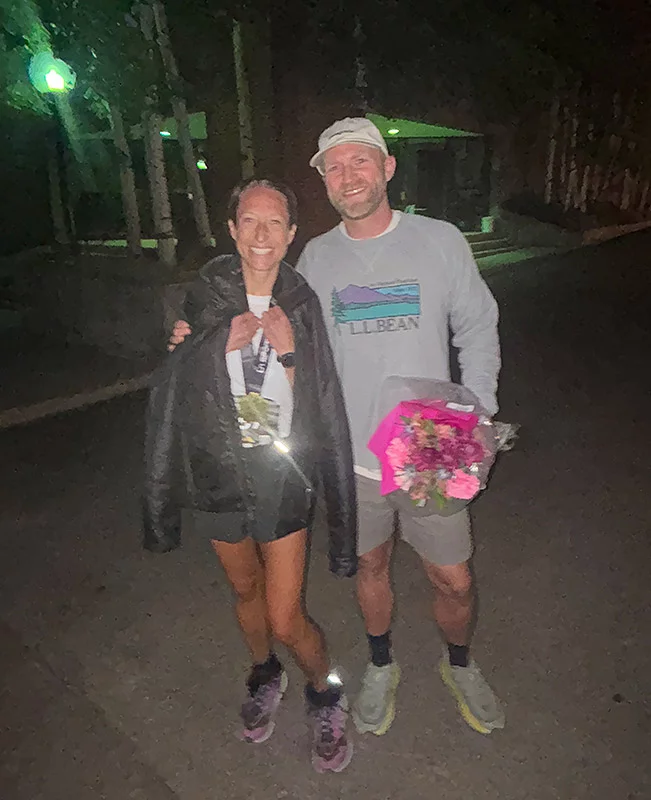
Patton asked her one time when they were dating about her running.
“Honestly, if I were to give you the top 10 things that make me who I am, running doesn’t even make the top 10,” Flower told him. “Yeah, it’s something I do and enjoy, but it’s not who I am.”
Patton said that being an ER doctor is the right fit for his wife.
“She has the perfect disposition for a doctor because she’s caring, she’s genuine, but she does not get stressed,” Patton said.
Flower and some friends recently launched a nonprofit called Mountains to Mountains. Their hope is to connect people who live in or enjoy mountain communities by sharing medical resources, offering training and developing support programs across those communities. Flower is the chief medical officer of the organization.
Asked whether she would consider becoming a sponsored runner, Flower hesitates.
“I still am very much enjoying what I do for my day job, and I don’t think that running is going to change that too much,” she said. “Running is something that I do out of pure enjoyment because I like it. It keeps me grounded. It keeps me sane. So I don’t want to trade that relationship that I have with the sport at this time.”
Flower chose not to run the Pikes Peak Ascent or Marathon races in nearby Manitou Springs in mid-September. The races fell on the same weekend as her first wedding anniversary with Patton. They celebrated in, where else, the mountains.
With her successes in Leadville this summer, Flower enjoyed a few weeks of fame. Some of the doctors in the hospital lounge asked her about her run. She made the rounds on ultrarunning podcasts, and her Instagram account blew up, growing from 500 to 6,500 followers in a matter of days. She recounted the race in a series of posts there, praising her crew and the race organizers.
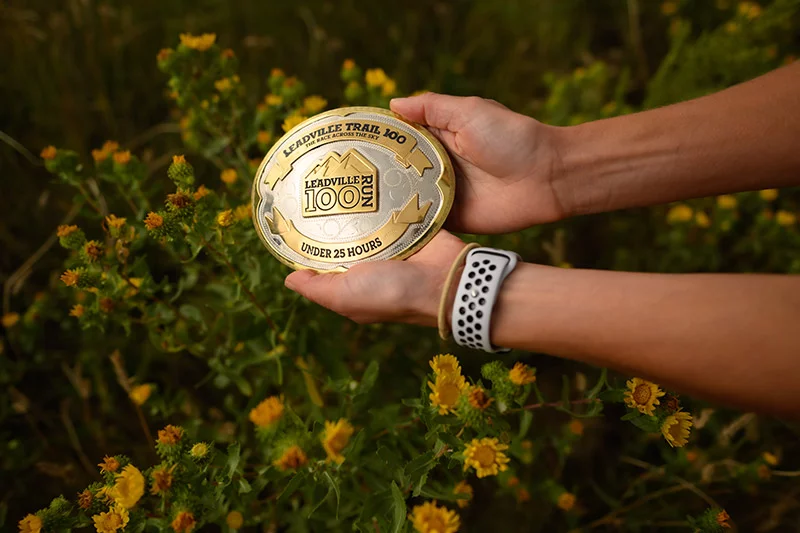
She is using these platforms to relay the details of her record-breaking run, as well as the joys of running. A recent episode of the Trail Society podcast featured Flower. She talked about the simple fact of being able to run. To be outdoors. To see how far she can push her body.
“Ultra running gives you this weird appreciation for just being here, for being healthy, for being alive.”
A new win after the Leadville 100
In early November, Flower pulled off another amazing win, setting a new 50-mile world record at the Tunnel Hill trail races in Vienna, Illinois. She averaged a 6:30-mile over the course.
USA Track and Field sanctioned the race, meaning Flower’s 5:18:57 finish sets a new world record by more than 10 minutes, pending her test results.
“It’s wild,” she said a few days after the race. “It’s been so long that I’ve been training at altitude, and then I went back for a sea-level race.”
The conditions were ideal: 40 degrees at the start and no rain. Flower said the Midwest autumn leaves were “awesome.”
In what she laughingly concedes has become a pattern for her this year, Flower decided to enter the race about two weeks before it took place. She had planned to visit family in the area and decided against a marathon, opting instead for the 50-mile distance.
Flower’s recent victories have prompted some soul searching for her and her husband.
“We talked a lot about ‘what do we want out of this?’” Flower said. “We have decided to lean into another year of running and racing for 2026.”
With the race season now over, Flower plans to maintain her fitness for the next two months and add uphill skiing to her regimen. That means hiking up a ski run, then skiing down, at ski areas that allow the practice.
Flower already is considering which competitive races to enter, including the Black Canyon Ultras in February in Arizona.
“I’m curious to see how I stack up to a lot of very professional runners,” she said.
Her year of running and racing will, of course, include ER shifts, she said.
“Medicine is still something I really enjoy,” she said. “It’s challenging. It’s fulfilling. It’s certainly not fun or easy all of the time. I would struggle to be as good at running if it was all that I did.”
